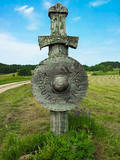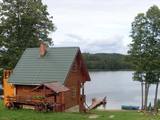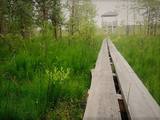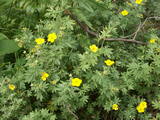| Нo | Название | Описание |
|---|---|---|
|
Tūrisma gide Ineta Jansone piedāvā ekskursijas grupām gar Kaņiera ezeru, iepazīstinot ar putniem, kuri mīt tā tuvumā. Kaņiera ezers ir vieta, kur migrācijas laikā apmetas daudzi tūkstoši ūdensputnu. Ezerā un tā apkārtnē sastopamas vairāk nekā 200 putnu sugu. Putnu vērotāju ērtībām vienā no Kaņiera ezera pussalām uzcelts putnu vērošanas tornis. Netālu no putnu vērošanas torņa izveidota koka laipa uz pontoniem, kura stiepjas cauri niedrāju audzei. Kaņiera ezers izceļas ar lielu daudzums zivju – tajā konstatētas gandrīz 20 zivju sugu. Izsens zvejnieku ciems - Lapmežciems atrodas skaistā vietā uz šauras zemes strēles starp Kaņiera ezeru un Rīgas jūras līci. Lapmežciemā izveidots zvejnieku muzejs, kuru var apmeklēt ekskursijas laikā, kā arī nobaudīt svaigi kūpinātas zivis. |
||
|
Основанный в 1973 году музей с 1989 года находится на месте хутора «Кална Зиеди». Здание, в котором находится постоянная экспозиция, построено в 1989 г. на фундаменте жилого дома, а хранилище (1990 г.) - на фундаменте хлева. Выставочный дом (2000 г.) находится на месте бывшего амбара. Таким образом, из построек бывшего хутора сохранился только погреб, но размещение построек соответствует типичной планировке Видземского двора. Музейный фонд посвящен истории края со времен каменного века. В его экспозиции под открытым небом представлены пчелиные ульи со знаками принадлежности и редко встречающиеся в Латвии круговые кресты, являющиеся надгробными памятниками средневековья. В 0,1 км к северо-востоку от музея находится (видно) городище «Кална Зиеди», а в 0,2 км к югу – остатки стволажертвенного дуба«Кална Зиеди» (погиб в 1994 г.), которые находятся на краю водохранилища Плявиньской ГЭС. |
||
|
Embūtes dabas parks, saukts par Embūtes senleju, ir viena no skaistākajām, interesantākajām un noslēpumainākajām Kurzemes vietām. Nav Latvijā otras tādas vietas, kur ieejas vārtus dabas parka teritorijā simbolizē stilizēti zobeni ar vairogiem ceļa abās pusēs, radot mītisku un cienījamu noskaņu. Par Embūtes apkārtnes vēsturi stāsta daudzas teikas un leģendas. Viena no pazīstamākajām ir romantiskā teika par kuršu vadoņa Induļa un vācu komtura meitas Ārijas mīlestību. Vietā, kur viņi pirmoreiz tikušies joprojām atrodas Ārijas un Induļa ozoli. Embūtes dabā parkā ieteicams apskatīt - ekotūrisma taku, Embūtes viduslaiku pilsdrupas, Embūtes luterāņu baznīcas mūrus, Induļa pilskalnu, Pilskalna avotiņu, Induļa un Ārijas ozolu. Dabas parks aprīkots ar labiekārtotu pastaigu taku, skatu platformām, skatu torni, labierīcībām un atpūtas vietu. |
||
|
Lauku māja atrodas Alksnis ezera krastā Aukštaitijas nacionālajā parkā. Ezers ir savienots ar pārējiem ezeriem, kas iekļaujas šinī parkā. Šī vieta ļoti piemērota makšķerniekiem un tiem, kuriem patīk baudīt mieru. Plaša viesistaba ar kamīnu, 2 guļamistabas, atsevišķs pirts namiņš, vieta ugunskuram, laivas nomai. |
||
|
Most popular Estonian resort with wide range of leisures and SPA offers. One of the rare Estonian sandy beaches. The Old Town has the main walker street - Rüütli tee. |
||
|
Taka ved cauri mežam uz skatu torni purva malā. Takā apskatāma Nāzara priede –priede, pie kuras 1905. gadā nošauts dumpinieks, pati priede – ekoloģiskais koks ar dzilnu kaltiem dobumiem, nokaltusi. Melnalkšņu dumbrājs - slīkšņa ar cūkaušiem un puplakšiem. Oleru purvs no skatu torņa – pārejas un sūnu purvs, kas izveidojies nolaista ezera vietā. Papildus objekti blakus takai, pieejami pa ceļu – Oleru muižas komplekss, Krustakmens, Oleru muižas kapi. Kopējais takas garums: 1,1 km. |
||
|
Находится в центре Салацгривы на площади Боцманя, около Салацы. Когда-то столь известная корчма «У боцмана» приобрела новый интерьер, связанный с тематикой барона Мюнхгаузена. Латышская кухня: Салат из селедки, селедка с творогом, рыбный суп, свиная грудинка с луком, серый горох с салом, жареная печень, жареная камбала, жареное филе судака, слойка из черного хлеба. |
||
|
This restricted area is on the eastern shore of Lake Ķīšezers, and of the greatest importance here are the habitats – flood-land and other meadows, dunes, the aquatorium of Lake Ķīšezers, the shoreline, forests of oak, black alder and other trees, and many huge oak trees in the restricted area and beyond its borders. The Bulduri castle hill, which is the most distinct ancient castle hill in Rīga, is on the southern end of the Lieupsala peninsula. On the border of the restricted area is an affiliate of the Latvian Open-Air Ethnographic Museum, which is known as “Vārnas”.
|
||
|
Matsalu muiža pirmoreiz vēsturiskajos avotos ir minēta 1560. g., kad tā ietilpa Lihulas bīskapijas sastāvā. Tagad redzamās ēkas ir celtas laikā no 18. gs. otrās puses līdz 20. gs. sākumam. Pagājušā gadsimta sešdesmitajos gados te plānoja izveidot Matsalu rezervāta centru, taču „veiksmīgā loze” tika netālu esošajai Penijē muižai (sk. iepriekš). Mūsdienās muižas pils, citas ēkas un parks (tajā dīķis ar salu) atrodas kritiskā stāvoklī. Taču kā nozīmīgu vēstures liecinieku arī šo muižu var iekļaut apskatāmo objektu sarakstā. Muižas komplekss atrodas pa ceļam uz Kēmu (Keemu) putnu vērošanas torni. |
||
|
Meklējama Gosporos, starp Rīgas – Daugavpils šoseju (A 6) un Daugavu. Apjomā nelielais dievnams būvēts 1820. gadā romāņu stilā no laukakmeņiem senas kapsētas vietā. Tuvāk Daugavai ir izveidota aka, no kuras iztek Svētavots, kam piedēvē dziednieciskas īpašības. Pie baznīcas novietots dobumakmens. |
||
|
Моленная Крустцельской старообрядческой общины.
Моленная построена в 1939 году.
|
||
|
Кишупе (длина 31 км) берет свое начало из болота Ледургской волости. На самом пляже Кишупе часто меняет русло и устье. Один из притоков Кишупе имеет интересное название – Пупалюрга. Название Кишупе, возможно, происходит от имени человека и названия дома. Поблизости от реки в 17 веке жил человек по имени Кисис. |
||
|
This is a swamp into which sulphurous waters flow, and it is on the left bank of the Abava River valley. This is the only place in Latvia where the protected shrubby cinquefoil is found in the wild. This bush covers approximately one-fifth of the restricted territory. It also includes forests, various kinds of meadows and sulphurous streams, including the one which is known as the Devil’s Eye. |
||
|
Длина тропы составляет около 1,2 км. Уникальной тропу делает холмистый рельеф леса (глубина оврагов местами достигает 15 м), разнообразие видов растений и живописные изгибы Каулиньупите, пересекающие тропу в двух местах. Тропа Жибгравас была создана в конце 90-х годов. |
||
|
Аэродром в Вайнёде в свое время был одним из крупнейших военных аэродромов Советской армии в странах Балтии. Однако, еще до этого, во времена Латвийской свободной республики здесь базировались первые латвийские дирижабли. Ангары для дирижаблей были снесены и перемещены в Ригу, в которых в наши дни находится Рижский центральный рынок. С аэродрома в Вайнёде поднимались и одни из первых латвийских планеров. В советское время на аэродроме базировался 27-й полк противовоздушной обороны и 54-й авиационный полк истребителей, в состав которого входили 38 истребителей СУ-27 «Flanker». После восстановления Латвийской свободной республики аэродром в Вайнёде частично разобран, и большие железобетонные панели, покрывающие взлетную полосу и прочую территорию взлетного поля, были использованы для благоустройства Лиепайского порта. Еще сегодня на аэродроме сохранилось около 16 ангаров и часть взлетно-посадочной полосы - 1800 м из 2500 м. Каждый заинтересованный может получить более полную информацию на эту тему в краеведческом музее Вайнёде.
|
||
|
Формирование парка было начато в 19-ом веке, в начале как ландшафтный парк с различными прогулочными дорожками, отдельной системой дорожек, скамеечек и мостиков. В настоящее время парк Казданги является одним из крупнейших (196 га) и дендрологически наиболее богатых усадебных парков в Латвии. Здесь насчитывается более 200 видов деревьев и кустарников, 127 из них - иностранные. Парк включает в себя весь поселок Казданга, в том числе и замок усадьбы Казданга, и территорию к северу от него, где находится семейное захоронение баронов Мантейфелей, формирование которого было начато в самом начале 20-го века, но работы были прерваны с началом Первой мировой войны. В парке обустроены зоны отдыха, декоративные элементы. В свою очередь, замок Казданга был построен около 1800 года. Автор этого проекта - известный в Европе архитектор Е.Г. Берлицс, который использовал проект архитектора Дж. Кварнеги. В состав усадебного ансамбля входили также Дом кавалеров, дом прислуги, жилой дом, конюшни, тройной мост через овраг и другие здания. В 1922 году в замке начала действовать Сельскохозяйственная школа. Сегодня здесь обустроен замковый музей Казданги и Туристический информационный центр. |
||
|
Сельский гостевой дом и дендрологический сад недалеко от Кулдиги. В пруду возле дома есть форель и карп. Рядом с гостевым домом находится Саулескалнский дендрарий, основанный в 1960 году. В настоящее время здесь произрастают около 100 видов деревьев и кустарников, в т.ч. 25 - местные виды и 16 видов рододендронов. Уникальные экземпляры - самая старая магнолия в Латвии (50 лет), 45-летняя скумпия кожевенная (Cotinus coggygria), гинкго двулопастный (Ginkgo biloba), элеутерококк колючий (Acanthopanax sessiliflorum) и др. Вход за пожертвование. Имеется также помещение исторической справки о хозяевах, которые создали этот сад. Здесь можно приобрести различные саженцы. |
||
|
В окрестностях Плявиняс и Стукмани поселение существовало уже в III веке. Во времена Польско-шведской войны (1600 -1629 гг.) у впадения Айвиексте в Даугаву стоял военный лагерь шведов, с тех времен сохранились укрепления – окопы. Это одно из впечатляющих подобного рода военных строений в Латвии. Плявиняс как крупное поселение начало образовываться в 90 годах XIX и начале XX столетия, после строительства железной дороги. Сегодня Плявиняс больше известен как место производства доломита и щебеня и весеннего наводнения. |
||
|
Чумной камень у церкви – на поверхности камня был вырублен текст (сейчас
стерся и не виден), согласно которому на ливов напал король Швеции Карл IX и
чума (камень находится в месте захоронения жертв чумы). Сейчас на то же место
поставлен и второй (самый маленький) камень, который когда-то находился у дома
«Пакални». Текст на камне стерся.
|
||
|
Ремесленницы из глины делают посуду, вазы, подсвечники, фонари, садовую керамику и изделия мелкой пластики. Интересно, что есть глиняная посуда с деревянными ручками. Предлагают экскурсию, наблюдение за работой гончара, возможность самому присесть к гончарному кругу, а также приобрести уже готовую продукцию. |
||



























